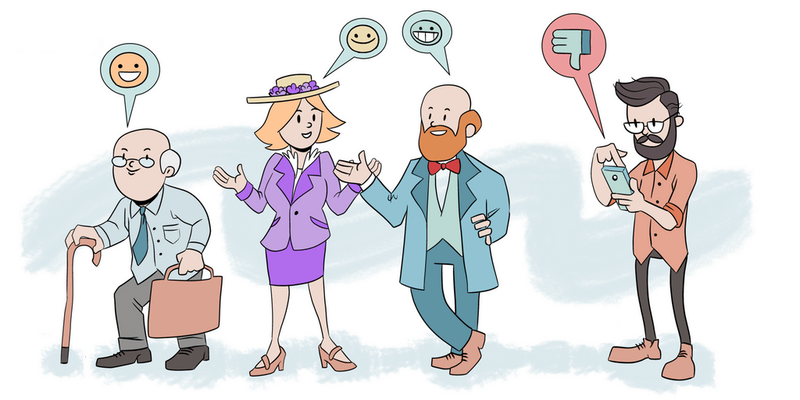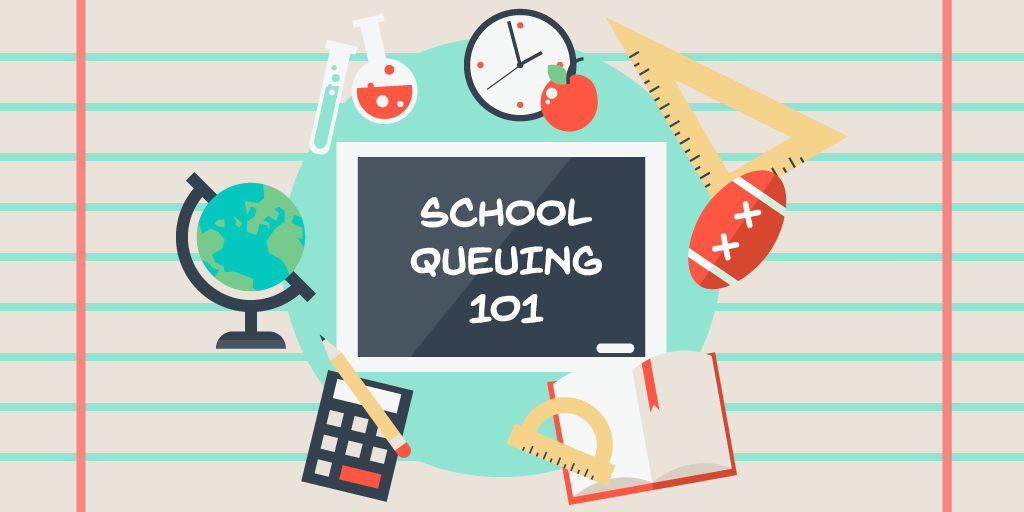If retail stores want to capture the fleeting attention of millennial consumers, they need to understand millennial shopping trends. Otherwise, they’ll miss out on a trillion dollar demographic.
That means recognizing that millennials have grown up in a fascinating age, where technology, economies, and a far smaller world have disrupted the traditional shopping experience.
The point being, your next queuing strategy has to appease millennials if you want to succeed — or, at the very least, outshine your competitors.
Before we can understand what kind of queue system to implement, we need to understand the “millennial”.
Let’s break out our dissection tools to chart the intersection where millennials and retail meet.
Millennials Love Service Innovation
What is a millennial? While bloggers and pundits have argued semantics about what it means to be a “millennial,” the general conclusion is that they’re a generation saturated with technology.
Checking Facebook statuses or the latest Instagram post is as natural as reading the paper with a cigarette once was for 20th-century nuclear families.
The notion that millennials are inseparable from their technologies permeates any discussion about them, including your next queuing strategy.
Just keep in mind, most millennials don’t like being called a “millennial”. They’re a little sensitive about their generational nomenclature.
Millennials by the Numbers

Looking at the numbers, millennial consumers look poised to block out the sun — affecting every facet of daily life.
Millennials became the largest generation in the United States labor force back in 2015, with 53.5 million bright-eyed youngsters clocking in and out of their shifts.
Meanwhile, Goldman Sachs’s research on millennials estimates there are 92 million millennials in the United States alone, making them the largest generation in US history.
That’s a lot of fresh faces with a disposable income for the first time in their lives.
Is more reasoning necessary for retailers to recognize that they need to meet the idiosyncrasies of this generation if they want to stay in business?
The Internet Isn’t Everything
The word “digital native” is often pinned to millennials like a forehead tattoo. While it doesn’t mean each millennial can build a computer, it also doesn’t mean millennials’ online shopping is all they do.
It’s important not to get carried away with terminology. Research on millennials suggests some surprising facts about millennials shopping trends.
During 2016’s Black Friday mayhem, nearly 50% of customers were below the age of 34. Contrary to popular belief, millennial consumers aren’t afraid to go outside, so long as they have motivation to do so.
Data on millennial retail trends suggests that where there’s a deal, there’s a millennial holding a locally made cup of coffee in one hand and a smartphone in the other.
Still, while millennials grace a store with their physical presence, they’ll be on their smartphones checking social media, reading reviews, paying their bills, and messaging friends.
It’s like an extension of their brains — can’t leave the house without it!
Millennials: A Frugal Generation

Let’s be clear. Just because millennials are willing to head to a retailer doesn’t mean they’re committed to making a purchase.
Millennials shopping trends have developed in the wake of 2008’s Great Recession — an event many countries, and millennials, still experience.
Combining an economic crisis, lower long-term maximal earnings, and a job market that prefers anxious freelancers over traditional nine-to-fives, it’s no wonder millennial consumers are cautious spenders.
Unlike previous generations, only 36 percent of millennials predict they will be financially better off than their parents, and 31 percent say they’ll be happier.
Sounds pretty gloomy, right?
But, rather than pessimism, research on millennials suggests cautious prudence, developed in the face of overwhelming information.
At the same time, a third of older Millennials are the best-educated demographic in American history, with four-year college degrees — or higher.
Meanwhile, research from Charles Schwab suggests that millennials are more likely to have a written financial plan.
Where are we going with this?
Well, millennials' spending habits are formed by careful deliberation — they intimately understand the importance of responsible money management. That means millennial spending habits are less prone to spur-of-the-moment purchases.
If millennial consumers going to purchase it’s because they feel they’re getting the best deal—or best experience—possible.
Short Service Times Lead to Best Customer Experiences
Instant gratification is the new norm.
You’re probably just as guilty of impatience without realizing it. If a website doesn’t load fast enough, your mind wanders off and you click off to something else.
Contrary to mother’s wisdom — “Good things happen to those who wait” — we live in a world where instant gratification is the accepted standard.
As soon as a millennial clicks “purchase", they want a drone to drop off the goods on their front lawn. Unfortunately for millennials and fortunately for retail, a future where patience is nonexistent is a ways off.
That doesn’t imply millennial consumers will wait around in a store. Long lines scare away millennials like the blinking notification of a low battery.
That's why it's important for businesses to take into account the length of their lines and the impact of customer service on retail.
Millennials: A Tough Sell Without Brand Loyalty

Millennial consumers don’t easily bend the knee to a brand — with the exception of social media platforms.
When an alternative is just one Google search away, there's always a risk of your customers leaving for your competitors.
Millennials' spending habits are inextricably tied to the internet.
When they pick up a product they also pick up their smartphone. A few swipes on the keypad — and they’re busy comparing and contrasting, looking for the best available deal.
Retailers and brands can stick out by providing exceptional customer experiences — something that occurs in person and online.
Nordstrom has been on Pinterest for years now, having accumulated over 4.5 million followers.
The retailer pinned items in-store with a red tag, indicating it’s a popular Pinterest item. And they used an item’s Pinterest popularity to determine what stock to purchase.
It’s a communication channel between millennials and Nordstrom. A way to say, “Hey! We’re listening to millennials' spending habits!”
While millennials may not swear fealty to a store like Nordstrom, it will sit on top of their list of places to shop.
Using It All to Improve Your Queues
Now it’s time to put away our scalpels and magnifying glasses and figure out how to put all this newfound knowledge on millennials into practice. All so that you could develop a better queuing strategy.
Mobile Integration
Enunciate “mobile” with me. Mobile integration is an excellent means of motivating millennials to set foot in your store, a way to unite millennials and retail.
Dunkin Donuts’ app is one of those epitomes that understands millennial spending habits.
On-the-go mobile ordering lets the hungry and impatient millennial tap what they want to purchase ahead of time and pick up their order without waiting in line.
Even better, millennial consumers can pay with the app — no seconds wasted taking out a wallet. It’s the efficient way to pay.
Going mobile is also the perfect means to enable millennials to receive positive feelings about the waiting line. When has that ever happened?
The mobile side tap into that fundamental tool of every millennial (and pretty much everyone else too) — smartphones. Used properly, they improve the entire retail customer experience.
But be careful: if you are a retailer who depend on customers to visit and look around, a remote queuing solution can backfire. Imagine if visitors came in just to pick up that one item — there’s no chance for an upsell.
Digital Screens
The proper term is “digital signage”, which is self-explanatory. It is a big flat-screen television that millennials waiting in line can look at.
It bears repeating that millennial consumers hate waiting. Give them something to do, to entertain themselves while they're stuck waiting in line.
Disney figured this one out back in 2000s. While guests waited in line to see a show, they were asked to text jokes, and if they were funny enough they would be used in the show.
Signage that motivates interactions mitigates the sense of being bored, keeping millennials entertained while they wait.
It also provides a great channel to foster relations between millennials and brands.
Let’s imagine a sign that asks millennials to complete a survey on, for example, Best Buy’s Facebook page. Or, maybe just have them write an opinion, or share a pun in a tweet. The winner receives a gift card or store credit or a coupon.
The takeaway is that the interaction is incentivized.
Not only does this type of interaction dull the sting of waiting in line for millennials, but it becomes a means of engagement between a millennial and retail.
In other words, engagement between a consumer and the brand.
Remember, the customer experience sets stores apart. And social media is typically the first interaction millennial consumers have with a retailer.
Consider this: 74% of millennials say their purchase decisions are influenced by social media.
Queuing Strategy for Millennials

Millennial consumers are here to stay, and understanding millennial shopping habits is key to any business’s future success.
Taken together and used properly, smart retailers can create a queuing strategy that appeals to millennials. Implementing a queue management for retail is certainly a way to go.
Take this 3-step guide:
A warm welcome from the staff, or involve some automation to impress visitors with innovation.
A digital signage with live updates of the queue. Provide SMS updates when applicable (for instance, in a large shopping area that you can’t cover with only a few TVs).
Gather service data, or Service Intelligence, and improve on existing figures.
It looks simple but in reality, providing a good customer experience is one of the most difficult things to master for a retail business.
Once you have the right queuing strategy for millennials, you'll soon start seeing your customers share "#ILoveThisShop" with their friends and family.
Want to try out this service strategy at your retail shop?
With a free 14-day Qminder trial, you can develop the best queuing strategy that takes Millennials into account.






